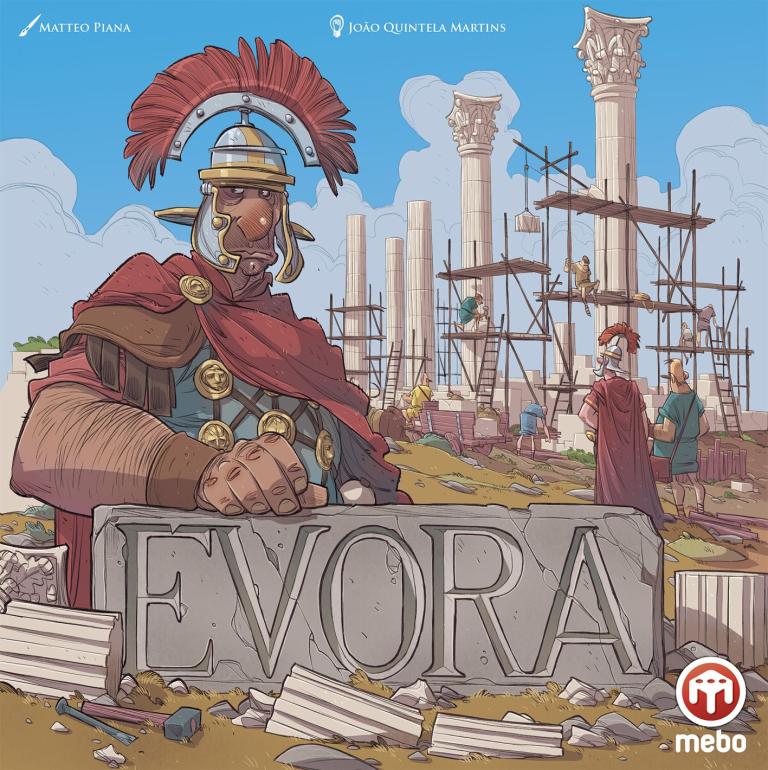Évora

Évora
The Roman temple of Évora was probably built in honor of Emperor Augustus. It was built in the 1st century AD in the main square (forum) of Évora - then called Liberalitas Julia.
In this game players will play the role of builders of the Roman Empire and the action takes place in Évora in the 1st century AD.
The objective: Build the 14 columns that still exist today on the site.
Players move their workers around the rondel to define the action they intend to perform: Build (stones and capitals), improve the columns already built (points multiplier) and request the influence of important characters (cards).
These characters are:
The Emperor who will value the columns at the end of the game.
The governor who will inspect the columns and during the game will compensate the player.
The centurion who maintain order in the construction site and will offer greater mobility to the player.
The architect who helps in the construction process making it much more effective and profitable.
The player who obtains the most prestige points, based on the stones placed in each column and also on bonuses, wins the game.
—description from publisher
O templo romano de Évora foi provavelmente construído em homenagem ao imperador Augusto, que era venerado como um deus, durante e após seu reinado.
Foi construído no século I d.C. na praça principal (fórum) de Évora - então chamada de Liberalitas Julia.Neste jogo os jogadores desempenharão o papel de construtores do Império Romano e a ação ocorre em Évora no século I d.C.
O objectivo: Construir as 14 colunas que ainda existem nos dias de hoje no local.
Este jogo tem a sua mecânica principal baseada num rondel e os jogadores movimentam os seus trabalhadores para definirem a ação que pretendem executar: Construir (pedras e capiteis), aperfeiçoar as colunas já construídas (multiplicador de pontos) e solicitar a influência de personagens importantes (cartas).
Estas personagens são:
O Imperador que valorizará as construções no final do jogo.
O governador que inspecionará as construções e durante o jogo compensará o jogador.
O centurião que mantêm a ordem no estaleiro e oferecerá maior mobilidade ao jogador.
O arquiteto que ajuda no processo de construção tornando-o muito mais eficaz e rentável.
Vence o jogador que obtiver mais pontos de prestigio baseado nas pedras colocadas em cada coluna e também nalgumas bonificações.
In this game players will play the role of builders of the Roman Empire and the action takes place in Évora in the 1st century AD.
The objective: Build the 14 columns that still exist today on the site.
Players move their workers around the rondel to define the action they intend to perform: Build (stones and capitals), improve the columns already built (points multiplier) and request the influence of important characters (cards).
These characters are:
The Emperor who will value the columns at the end of the game.
The governor who will inspect the columns and during the game will compensate the player.
The centurion who maintain order in the construction site and will offer greater mobility to the player.
The architect who helps in the construction process making it much more effective and profitable.
The player who obtains the most prestige points, based on the stones placed in each column and also on bonuses, wins the game.
—description from publisher
O templo romano de Évora foi provavelmente construído em homenagem ao imperador Augusto, que era venerado como um deus, durante e após seu reinado.
Foi construído no século I d.C. na praça principal (fórum) de Évora - então chamada de Liberalitas Julia.Neste jogo os jogadores desempenharão o papel de construtores do Império Romano e a ação ocorre em Évora no século I d.C.
O objectivo: Construir as 14 colunas que ainda existem nos dias de hoje no local.
Este jogo tem a sua mecânica principal baseada num rondel e os jogadores movimentam os seus trabalhadores para definirem a ação que pretendem executar: Construir (pedras e capiteis), aperfeiçoar as colunas já construídas (multiplicador de pontos) e solicitar a influência de personagens importantes (cartas).
Estas personagens são:
O Imperador que valorizará as construções no final do jogo.
O governador que inspecionará as construções e durante o jogo compensará o jogador.
O centurião que mantêm a ordem no estaleiro e oferecerá maior mobilidade ao jogador.
O arquiteto que ajuda no processo de construção tornando-o muito mais eficaz e rentável.
Vence o jogador que obtiver mais pontos de prestigio baseado nas pedras colocadas em cada coluna e também nalgumas bonificações.
Player Count
2
-
4
Playing Time
30
-
60
Age
8
Year Released
2022
Newest Review
Remote video URL

